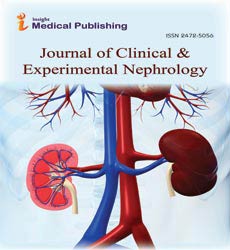Abstract
The Prognostic Significance of IgG4 Deposition in Membranous Nephropathy and Its Impact on the Therapeutic Regimen
Objectives: To assess the prognostic value of IgG4 reactivity in biopsy-proven cases of idiopathic membranous nephropathy (iMN) and to outline its potential in guiding therapy.
Methods: A retrospective study of biopsy-proven iMN cases from January 1997 to August 2013 was undertaken. Patients were identified, and an extensive analysis of the clinical and histological parameters were performed. The primary endpoint was a worse renal outcome, which was defined as doubling of the serum creatinine baseline value.
Results: The study included 52 patients, with mean age of 38.0 years. The median baseline creatinine was 112.7 ± 36.3 umol/l among those with positive staining for IgG4 and 67.4 ± 19.3 umol/l among those with negative staining for IgG4 (P=0.5). There was no significant difference in the 24 hr urine protein between IgG4 positive and IgG4 negative staining cases (P=0.375). The probability of doubling serum creatinine was similar among those with or without IgG4 deposition. Follow up of the patients revealed that 23.4% of those with positive IgG4 and 14% of those with negative IgG4 had deterioration of the renal function. The prevalence and severity of tubulo-interstitial inflammation was not statistically different between the two groups.
Conclusion: There was no relationship between IgG4 positivity and the severity of clinical and/or histological parameters in patients with iMN. IgG4 reactivity had no impact on the long-term outcome of the patients. Further studies are needed to outline the potential use of targeted therapy against IgG4 auto-antibody in a certain category of patients with membranous nephropathy.
Author(s):
Hala Kfoury, Sufia Husain, Hisham Alkhalidi, Doaa AlGhamdi, Jose Manuel El Asmar, Patrick Bou Samra, Abdulkareem Alsuwaida, Mohammad Alkhowaiter and Mohammad Alghonaim
Abstract | Full-Text | PDF
Share this

Google scholar citation report
Citations : 387
Journal of Clinical & Experimental Nephrology received 387 citations as per google scholar report
Abstracted/Indexed in
- Google Scholar
- Sherpa Romeo
- China National Knowledge Infrastructure (CNKI)
- Directory of Research Journal Indexing (DRJI)
- WorldCat
- Publons
- Secret Search Engine Labs
Open Access Journals
- Aquaculture & Veterinary Science
- Chemistry & Chemical Sciences
- Clinical Sciences
- Engineering
- General Science
- Genetics & Molecular Biology
- Health Care & Nursing
- Immunology & Microbiology
- Materials Science
- Mathematics & Physics
- Medical Sciences
- Neurology & Psychiatry
- Oncology & Cancer Science
- Pharmaceutical Sciences

